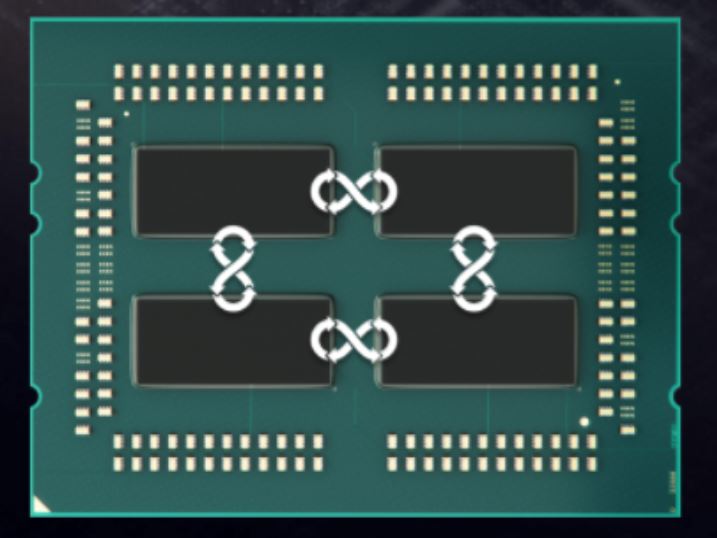AMD Ryzen Threadripper 1900X CPU Review
Why you can trust Tom's Hardware
Overclocking, Infinity Fabric & Test Setup
The Architectural Bits
The Ryzen 7 series features a single-die design, whereas AMD's Threadripper models employ a quad-die package with just two of its dies active. That means the 8C/16T 1900X effectively wields a dual-die arrangement with four active cores in each die.
Our first slide below shows the alignment of AMD's 16C/32T Ryzen Threadripper 1950X. Each die contains a pair of four-core CPU complexes (CCXes) that incur increased latency when they communicate with the neighboring CCX (denoted as CCX0 and CCX1). Another layer of latency comes into play when they communicate with the CCXes resident on the second die (marked as Die1). Simplified, the greater distance between dies means that die-to-die latency is much higher than the latency between two CCXes resident on the same piece of silicon.
The larger Threadripper models distribute active cores across both CCXes inside each die. The second slide shows how AMD disables one core per CCX (blocked out in blue) to create the smaller 12C/24T 1920X model.
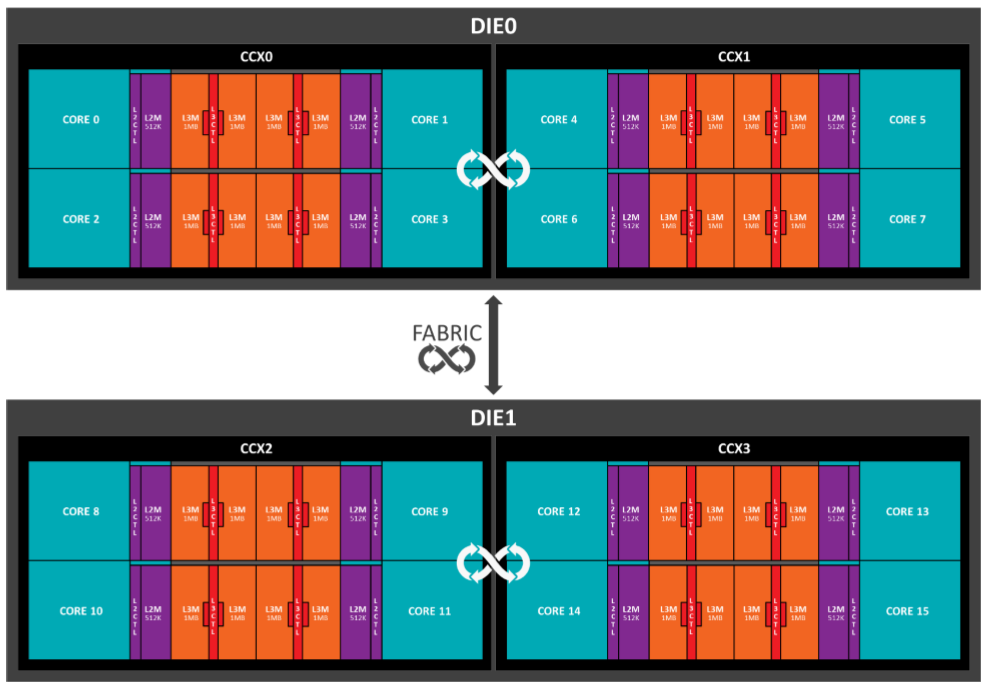
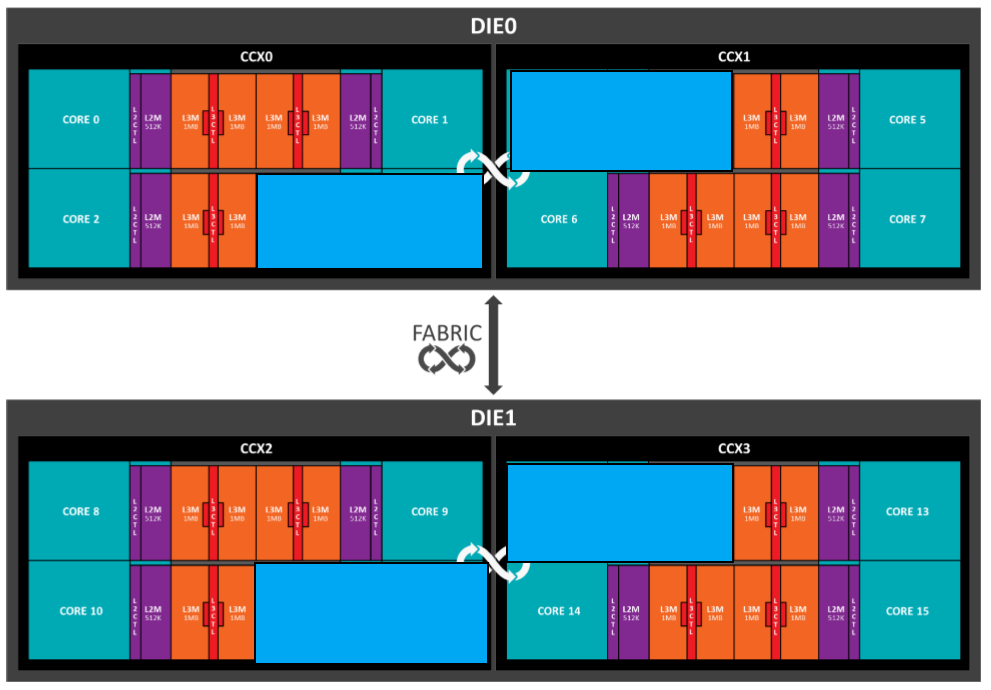
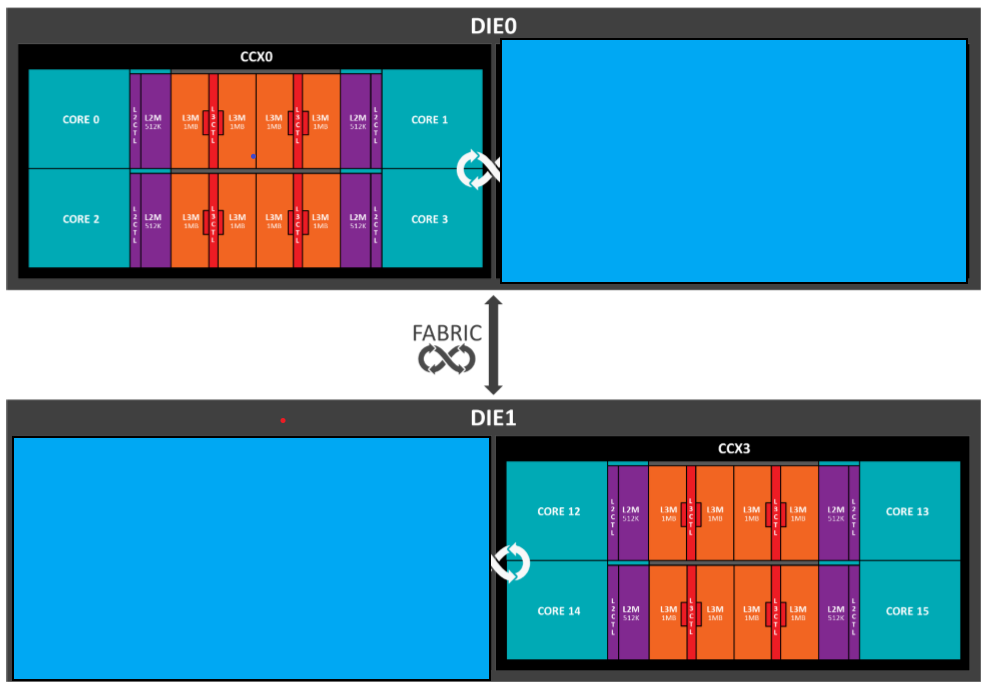
AMD takes an entirely different tack with its 1900X, as seen on the third slide. In a bid to eliminate one layer of latency, AMD confines the 1900X's active cores to a single CCX inside each die. The adjustment makes sense; spreading the cores evenly across all four CCXes increases the chance of incurring latent communication with neighboring CCXes.
Disabling two entire CCXes also has other implications, though. Inactive cores, provided they are near active cores, can absorb excess heat, potentially improving overclockability. Case in point: it's common to achieve lower overclocks on the 16C 1950X than the 12C 1920X. Consequently, the 1900X's clustered cores should reduce latency, eliminating the CCX-to-CCX delay entirely and only leaving us with die-to-die latency. But they could also potentially hamper overclocking.
The Infinity Fabric Breakdown
A few quick tests with SiSoftware's Sandra Multi-Core Efficiency test illustrate the consequence of AMD's design decisions. Flipping the 1900X into Creator Mode, with all eight cores active, results in three distinct layers of latency. In contrast, the 1950X in Creator Mode has four layers.
Switching the 1900X into Game Mode disables one entire die, leaving us with a 4C/8T processor that has only two layers of latency. Again, the 1950X in Game Mode has a third layer that affects performance. But the 1900X in Game Mode also achieves the lowest fabric bandwidth in our line-up of AMD models.
Get Tom's Hardware's best news and in-depth reviews, straight to your inbox.


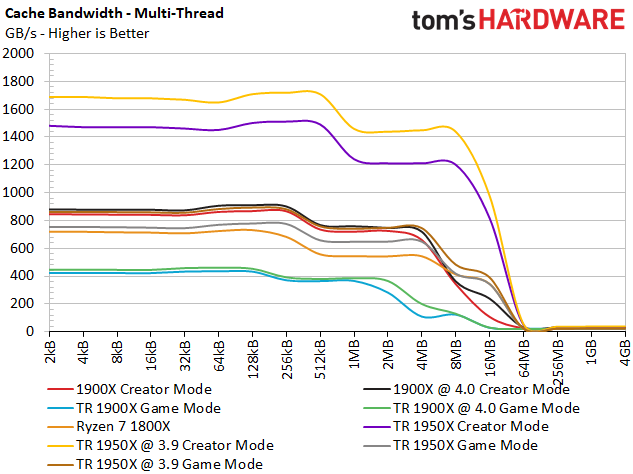
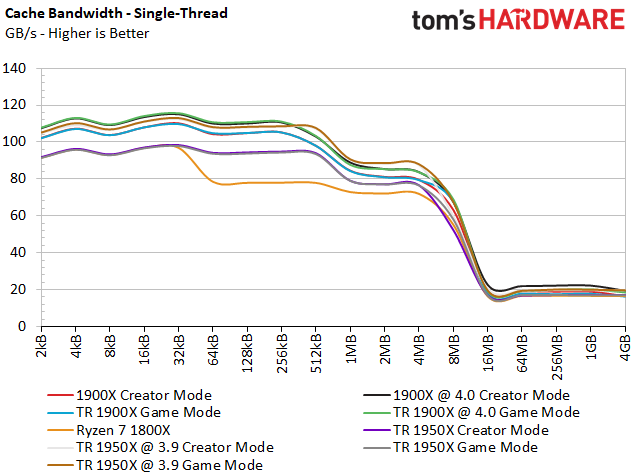
Finally, the two disabled dies remove a total of 16MB of L3 cache from the 1900X. That means it offers half of the multi-threaded cache bandwidth of the 1950X in Game and Creator Mode. Incidentally, the 1900X demonstrates less multi-threaded throughput than Ryzen 7 1800X in Game Mode. But the 1800X also proffers eight cores with simultaneous multi-threading, while the 1900X in Game Mode drops to a 4C/8T processor with only 8MB of L3 cache. Many games are sensitive to memory and cache performance, so it will be interesting to see how that plays out in our game testing.
Overclocking
Overclocking the 1900X was an exercise in simplicity. We merely adjusted the data rate to DDR4-3200 and set timings at 14-14-14-34. We increased Vcore to 1.39V, well below AMD's recommended maximum of 1.45V, and adjusted the SoC voltage to 1.1V. This proved stable up to 4 GHz during extended stress tests. However, even in the face of unsafe voltages, we were unable to attain a stable 4.1 GHz overclock to match our efforts with the 12-core Threadripper 1920X. Dialing back the memory frequency didn't help, either. Considering that AMD supposedly selects the top 5% of its dies for Threadripper CPUs, you might assume that the clustered active core arrangement comes into play. We only see a 100 MHz reduction, so it's more likely that our retail sample is simply on the lower end of the bell curve.
It's notable that a 4 GHz overclock might actually hamper the 1900X's performance in lightly threaded workloads, since we lose the benefit of a quad-core 4.2 GHz XFR boost.
Test Systems
| Test System & Configuration | |
|---|---|
| Hardware | AMD Socket SP3 (TR4)AMD Ryzen Threadripper 1950X, 1920X, 1900XAsus X399 ROG Zenith Extreme4x 8GB G.Skill Ripjaws V DDR4-3200 @ 2666 and 3200 MT/sIntel LGA 2066Intel Core i7-7820XMSI X299 Gaming Pro Carbon AC4x 8GB G.Skill Ripjaws V DDR4-3200 @ 2666 and 3200 MT/sAMD Socket AM4 AMD Ryzen 7 1800XMSI X370 Xpower Gaming Titanium2x 8GB G.Skill RipJaws V DDR4-3200 @ 3200 MT/sIntel LGA 1151 Intel Core i7-7700K MSI Z270 Gaming M72x 8GB G.Skill RipJaws V DDR4-3200 @ 2666 and 3200 MT/sAll EVGA GeForce GTX 1080 FE 1TB Samsung PM863 SilverStone ST1500, 1500W Windows 10 Creators Update Version 1703Corsair H115i |
MORE: Best CPUs
MORE: Intel & AMD Processor Hierarchy
MORE: All CPUs Content
Current page: Overclocking, Infinity Fabric & Test Setup
Prev Page Eight Cores For The High-End Desktop Next Page VRMark, 3DMark & AotS: Escalation
Paul Alcorn is the Editor-in-Chief for Tom's Hardware US. He also writes news and reviews on CPUs, storage, and enterprise hardware.
-
rcrossw My 1900x is on an Asus Prime X399-A and running stable at 4190 Ghz. Temp 44 C. Prior to the 403 Bios it ran at 4225 Ghz.Reply
This is to let others know what I was able to do with the 1900x. I use a Ryzen 1700 for gaming. I do Photo work and Ballistics, on the 1900x. For what I use it for it is superb product. One last thing - I run both systems at 4K Res. Better on my older eyes. -
TechyInAZ Excellent review. I've been waiting for this review for a while since it's the strangest threadripper CPU in the family. Specifically i was wondering if they were going to do two cores per CCX, glad they decided to do just all 4 in one CCX for better latency.Reply -
Kawi6rr Is Threadripper a gaming CPU? If not then why do you test in so many games? Doesn't make sense.Reply -
Paul Alcorn Reply20301236 said:Is Threadripper a gaming CPU? If not then why do you test in so many games? Doesn't make sense.
31 tests for applications. Some tested with both native CPU processing and OpenCL acceleration. Also, four synthetics that measure key performance traits.
10 games, four synthetics.
-
antonysg77 For a normal user who also plays games, Ryzen 7 1700 is a powerful processor, which is power efficient and also comes with its own cooling solution. Also, both the processor and motherboard are very reasonably priced.Reply -
mapesdhs Reply20301281 said:31 tests for applications. Some tested with both native CPU processing and OpenCL acceleration. Also, four synthetics that measure key performance traits that are applicable to some apps.
Bit odd basing the conclusion on tests that are not by the initial introduction representative of the target market for the product. Why does everything have to be about gaming?? If the CPU isn't aimed at gamers in the conventional sense then surely it makes more sense to test it based on the kind of task it is aimed at? For example, setup an X399/1900X system with four GPUs for CUDA in AE or somesuch, compare it to the same GPU config on an X299 board, how do they behave? Efficiency, power consumption, render times, stability during an intense render, etc.
At the very least do some tests at 4K while streaming and show how the systems compare under such a scenario, such as GN has done for various CPU comparisons.
Ian.
-
cryoburner Reply20301236 said:Is Threadripper a gaming CPU? If not then why do you test in so many games? Doesn't make sense.
It makes sense in that they can show that to people who might be considering going with it for a gaming system. Some people tend to think that just because some piece of hardware is more expensive that it will be better for gaming, when in reality that hardware may cost more because it adds features that don't even provide much benefit to games. The 1900X enables quad channel memory with a higher maximum memory limit, but games won't benefit from that, and 16GB of dual channel memory should work just as well for years to come. Likewise, a gaming system won't likely see much benefit from having a CPU with 64 PCIe lanes. Someone wanting an 8 core processor for a gaming system would likely get comparable performance by overclocking a Ryzen 1700 on an X370 motherboard for several hundred dollars less. The same goes for other HEDT processors with lots of cores like the other Threadripper parts and Intel's equivalents. For gaming, those extra cores won't likely provide any benefit, and will likely only make it harder to keep the chip cool,resulting in lower clock rates if anything. Of course, there will also be some people who want those extra hardware features for specific tasks other than gaming, but may want to be able to game on the system as well. -
anbello262 Reply20301236 said:Is Threadripper a gaming CPU? If not then why do you test in so many games? Doesn't make sense.
This site is aimed mainly at gamers, so it makes sense to base the conclusion on gaming performance. You just seem to be upset that "someone might read this the wrong way and think AMD sucks", as if our job would be caring for the companies best interests.
They can do their own marketing, the job of Tom's is to give us all the information in the most scientifically accurate way possible, and then sum it up with a conclusion aimed at their readers, who are mostly gamers.
If you are not a gamer, then you can just read the pages with the productivity apps, and just ignore the conclusion (since it will not apply to you). There is no misrepresentation or false information anywhere in the article -
Paul Alcorn Well, the conclusion also takes application performance into account.Reply
"The real competition happens in our application workloads."
Also, there are seven application price efficiency charts in the conclusion. -
Nintendork BILLY GATESReply
Dunno if you forgot than with any TR chip you will get the full 64pcie lanes + ECC support. Where can you find that even on the 2K i9? Well, you won't.
